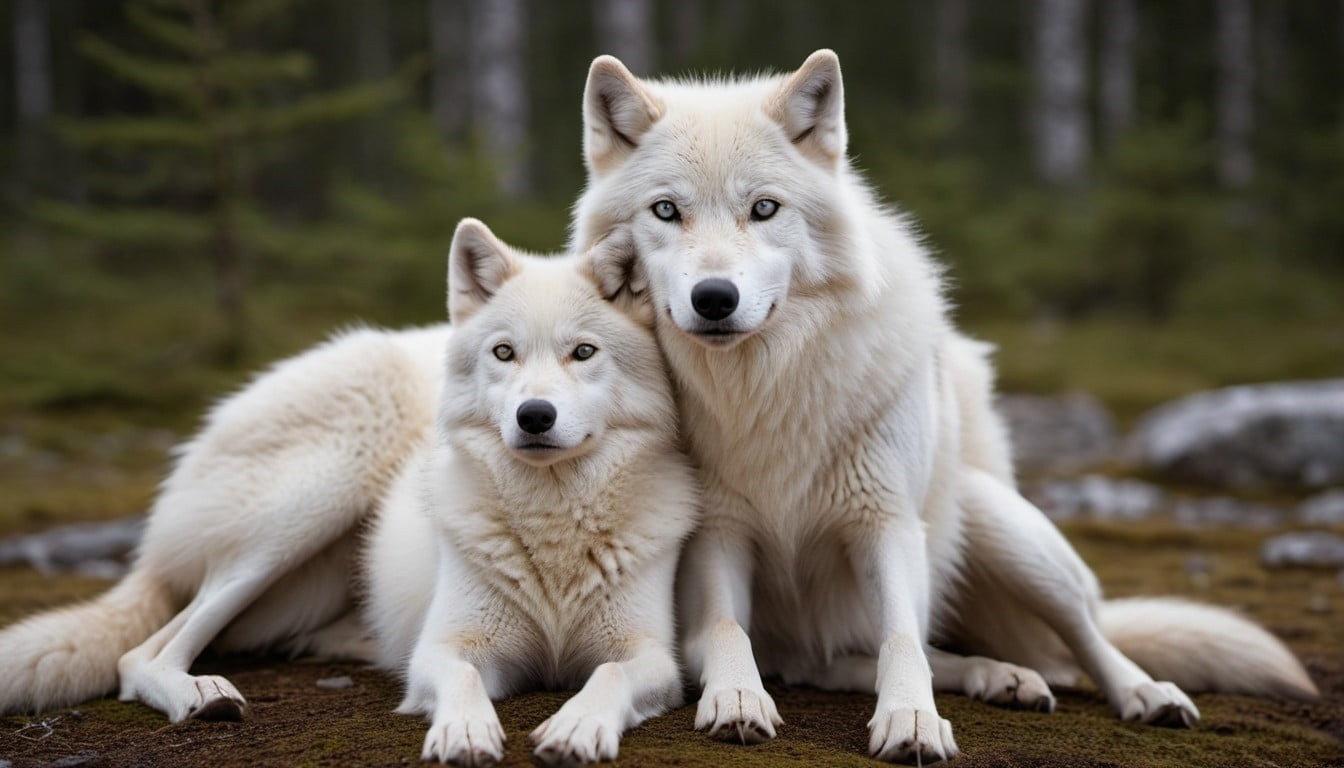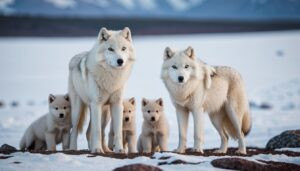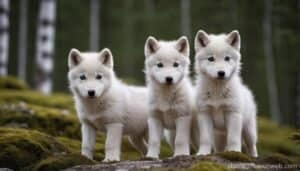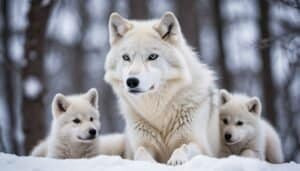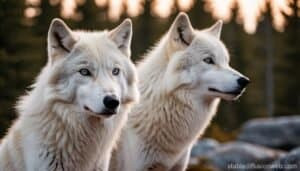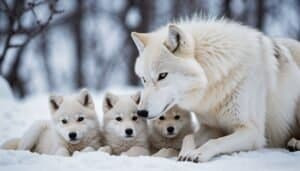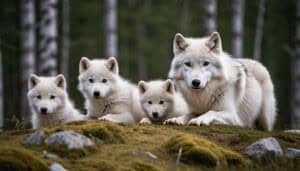Introduction
The reproductive organs of Arctic wolves are specialized structures that enable these resilient animals to thrive in one of the planet’s harshest environments
This article will delve into the detailed anatomy of both male and female Arctic wolves, explore their mating and reproduction behaviors, and discuss how they care for their young. By understanding these aspects, we gain insight into the life cycle of Arctic wolves and their adaptability to the extreme conditions of the Arctic
Male Arctic Wolf Reproductive Organs
Male Arctic wolves, like other canines, have specific reproductive organs that play a crucial role in reproduction. Understanding these organs’ anatomy and function helps shed light on how Arctic wolves reproduce and ensure the survival of their species in the harsh Arctic environment
Primary Organs
The primary reproductive organs of a male Arctic wolf include the testes, epididymis, vas deferens, and penis. These organs work together to produce, store, and deliver sperm to the female during mating:
Testes: The testes are the male gonads responsible for producing sperm and testosterone, the hormone essential for sexual development and reproductive functions. In Arctic wolves, the testes are located in the scrotum, which helps regulate their temperature, essential for viable sperm production
Epididymis: Attached to each testis, the epididymis is a long, coiled tube where sperm mature and are stored. This maturation process is crucial for the sperm to gain the ability to fertilize an egg
Vas Deferens: The vas deferens are tubes that transport mature sperm from the epididymis to the urethra in preparation for ejaculation. This transport mechanism is vital for delivering sperm during copulation
Penis: The penis is the organ through which sperm is delivered to the female’s reproductive tract. It contains the urethra, which also serves as the conduit for urine. During mating, the penis becomes erect, allowing for successful sperm transfer
Function and Anatomy
Each of these organs plays a crucial role in the reproductive process, ensuring that all the necessary stages for the reproduction and development of a new organism are carried out efficiently and in a coordinated manner:
Testes: Besides sperm production, the testes secrete testosterone, influencing secondary sexual characteristics, such as increased muscle mass and the development of mating behaviors
Epididymis: The maturation of sperm within the epididymis is a complex process involving biochemical changes that enable sperm to swim efficiently and recognize the egg for fertilization
Vas Deferens: During ejaculation, the smooth muscle walls of the vas deferens contract rhythmically to propel sperm forward. This coordinated movement ensures that sperm reach the urethra and are mixed with seminal fluid to form semen
Penis: The penis of an Arctic wolf, like other canines, has a bone called the baculum, which aids in copulation. The presence of the baculum allows for prolonged mating sessions, increasing the chances of successful fertilization
Understanding the male reproductive organs’ anatomy and function highlights the intricate biological mechanisms that enable Arctic wolves to reproduce. These organs ensure that sperm are produced, matured, and delivered effectively, allowing for the continuation of the species in the challenging Arctic environment
Female Arctic Wolf Reproductive Organs
Female Arctic wolves possess a complex reproductive system that is integral to their role in the continuation of the species. These organs facilitate ovulation, fertilization, gestation, and birthing, ensuring the next generation of Arctic wolves can thrive in the extreme conditions of their habitat
Primary Organs
The primary reproductive organs of a female Arctic wolf include the ovaries, fallopian tubes, uterus, and vagina. Each organ has a specific function essential for reproduction:
Ovaries: The ovaries are the female gonads responsible for producing eggs (ova) and secreting hormones like estrogen and progesterone. These hormones regulate the reproductive cycle and prepare the body for potential pregnancy
Fallopian Tubes: Also known as oviducts, the fallopian tubes transport eggs from the ovaries to the uterus. Fertilization of the egg by sperm typically occurs within these tubes
Uterus: The uterus is a muscular organ where the fertilized egg implants and develops into a fetus. It provides nourishment and protection to the growing embryos during gestation
Vagina: The vagina is the canal that connects the external genitalia to the uterus. It serves as the site for sperm deposition during mating and acts as the birth canal during delivery
Function and Anatomy
Each of these organs plays a crucial role in the reproductive process:
Ovaries: Besides producing eggs, the ovaries release hormones that regulate the estrous cycle, or heat, which is the period when the female is receptive to mating. This cycle ensures that mating occurs at the optimal time for fertilization
Fallopian Tubes: The movement of the egg through the fallopian tubes is facilitated by tiny hair-like structures called cilia and muscular contractions. If sperm are present, fertilization occurs in the tube, and the fertilized egg, or zygote, moves toward the uterus for implantation
Uterus: The lining of the uterus, known as the endometrium, thickens in preparation for pregnancy. If fertilization occurs, the zygote implants in the endometrium, where it receives nutrients and develops into an embryo. The uterus expands to accommodate the growing fetus during gestation
Vagina: During mating, the male’s penis deposits sperm into the vagina, where they travel through the cervix to reach the uterus and fallopian tubes. The vagina’s elasticity and muscular structure also enable it to stretch significantly during childbirth, allowing the pups to be born
Understanding the female reproductive organs’ anatomy and function reveals the sophisticated biological processes that enable Arctic wolves to reproduce successfully
These organs work in harmony to ensure that eggs are produced, fertilized, and nurtured through gestation, ultimately resulting in the birth of new pups that will continue the lineage of Arctic wolves in their frigid environment
Mating and Reproduction
Mating and reproduction in Arctic wolves are fascinating processes adapted to the extreme Arctic environment. These processes ensure the survival and continuation of the species despite the harsh conditions they face
Mating Season
The mating season for Arctic wolves typically occurs once a year, between January and March. This timing ensures that the birth of pups coincides with the spring and summer months, when conditions are more favorable for their survival:
Timing: The annual timing of the mating season is crucial for the pups’ survival. Births in late spring or early summer provide the young with a few months of warmer weather to grow and develop before facing the harsh winter
Estrous Cycle: Female Arctic wolves go into estrus, or heat, during this period, which lasts for about 5 to 14 days. During estrus, the female is receptive to mating, and hormonal changes prepare her body for potential pregnancy
Courtship and Mating Behavior
Courtship and mating behavior in Arctic wolves involve a series of intricate interactions that strengthen the pair bond and ensure successful reproduction:
Pair Bonding: Arctic wolves are generally monogamous, forming long-term pair bonds. The alpha male and alpha female lead the pack and are typically the only ones to mate, ensuring that their strong genetic traits are passed on to the next generation
Courtship Rituals: Courtship involves various behaviors such as nuzzling, grooming, and vocalizations. These behaviors reinforce the bond between the mating pair and signal readiness for copulation
Copulation: During mating, the male mounts the female from behind. The mating process can be prolonged, often lasting 10 to 30 minutes, due to the presence of the baculum (penile bone) in males, which aids in copulation. This prolonged mating increases the likelihood of successful fertilization
Gestation Period
The gestation period in Arctic wolves is about 63 days. During this time, the fertilized eggs develop into embryos and eventually into fully formed pups ready for birth:
Early Gestation: In the early stages of gestation, the fertilized eggs implant in the uterine lining and begin to grow. The mother’s body undergoes various physiological changes to support the developing embryos
Late Gestation: As the pregnancy progresses, the embryos develop into pups, gaining size and strength. The mother’s nutritional needs increase, and she may become more protective and less active as birth approaches
Litter Size
The average litter size for Arctic wolves ranges from 4 to 6 pups, although larger litters are possible. The size of the litter can be influenced by factors such as the mother’s health, age, and environmental conditions:
Birth: The pups are born blind and deaf, entirely dependent on their mother and the pack for survival. They are typically born in a den, which provides shelter and protection from the harsh environment
Early Development: During the first few weeks, the pups rely on their mother’s milk for nutrition. As they grow, they begin to eat regurgitated food provided by the pack members and gradually start to explore their surroundings
Mating and reproduction in Arctic wolves are finely tuned processes that ensure the species’ survival in the Arctic’s demanding conditions
By timing their reproductive cycle to coincide with the more favorable seasons, and through their complex courtship and mating behaviors, Arctic wolves maximize the chances of their pups surviving and thriving in their challenging environment
Raising the Young
Raising the young is a critical phase in the life cycle of Arctic wolves, requiring coordinated effort and cooperation from the entire pack. This collective approach enhances the survival rates of the pups, preparing them for the harsh realities of the Arctic environment
Parental Care
Parental care in Arctic wolves is characterized by a high degree of involvement from both the mother and the pack members. This communal effort ensures that the pups receive adequate nutrition, protection, and socialization:
Mother’s Role: The mother plays the primary role in nursing and caring for the newborn pups. She stays in the den with them for the first few weeks, providing warmth and feeding them with her milk
The mother’s presence is crucial for the pups’ early development, offering both nourishment and protection
Pack Support: Other pack members, including the father and subordinate wolves, play significant roles in raising the young. They help by bringing food to the mother and pups, guarding the den, and even babysitting the young when the mother needs to leave temporarily
This cooperative behavior increases the survival chances of the entire litter
Weaning and Feeding: As the pups grow, they transition from mother’s milk to solid food. Pack members often regurgitate pre-digested food for the pups, gradually introducing them to the diet of adult wolves
This process helps the pups develop strong digestive systems capable of handling the raw meat that constitutes their adult diet
Survival in Harsh Conditions
Survival in the Arctic’s extreme conditions requires that the young wolves quickly develop the skills and behaviors necessary to thrive in their environment. The early months of a pup’s life are critical for learning and adaptation:
Shelter and Protection: The den provides a safe and warm environment for the pups in their early stages of life. Located in a secure and often concealed area, the den protects the young from predators and harsh weather conditions
Pack members vigilantly guard the den, ensuring the pups’ safety
Learning and Socialization: Socialization is a vital aspect of the pups’ development. Through interactions with their littermates and other pack members, pups learn essential behaviors such as hunting techniques, pack hierarchy, and communication skills
Play-fighting and mimicking adult behaviors help the pups practice and refine these skills in a safe environment
Physical Development: The Arctic environment demands physical robustness and endurance. Pups engage in playful activities that build their strength and coordination
As they grow older, they start accompanying the adults on hunts, gradually learning the skills necessary for survival in the wild
Adaptation to Environment: Arctic wolf pups must adapt quickly to the rapidly changing weather conditions of the Arctic. Their thick fur develops early, providing insulation against the cold
Additionally, they learn to navigate and hunt in the snow and ice, which is crucial for their survival as they mature
Raising the young in the Arctic wolf pack is a collective endeavor that extends beyond the mother’s care. The involvement of the entire pack ensures that the pups are well-nourished, protected, and equipped with the necessary skills to face the challenges of their environment
This collaborative approach not only enhances the survival rates of the young but also strengthens the pack’s cohesion and effectiveness in the harsh Arctic landscape
Conclusion
The reproductive organs and behaviors of Arctic wolves are finely tuned to ensure the survival of their species in the harsh conditions of the Arctic. Both male and female wolves possess specialized reproductive systems that facilitate successful mating, gestation, and birth
The pack’s cooperative nature plays a crucial role in raising the young, providing them with the protection, nourishment, and skills necessary to thrive in their challenging environment
From understanding the intricacies of their reproductive anatomy to observing the communal efforts in raising the young, we gain a deeper appreciation for the resilience and adaptability of Arctic wolves. Their ability to navigate and prosper in such an extreme environment is a testament to their evolutionary success
The male Arctic wolf’s reproductive organs, including the testes, epididymis, vas deferens, and penis, are essential for producing and delivering sperm
In contrast, the female’s ovaries, fallopian tubes, uterus, and vagina play pivotal roles in ovulation, fertilization, and nurturing the developing pups. Mating and reproduction are timed to coincide with the more favorable spring and summer months, ensuring the young have the best chance of survival
The pack’s role in raising the young is crucial, with members providing food, protection, and socialization. This collective effort not only enhances the pups’ survival rates but also strengthens the pack’s unity and resilience against the Arctic’s harsh conditions
Through this intricate and cooperative process, Arctic wolves continue to thrive and adapt to one of the planet’s most unforgiving environments
